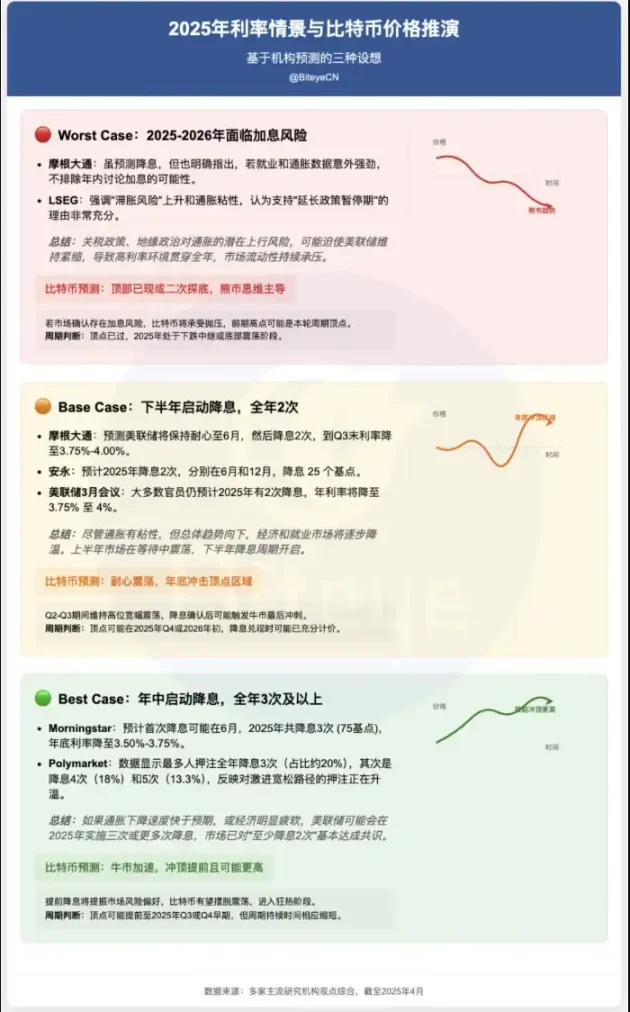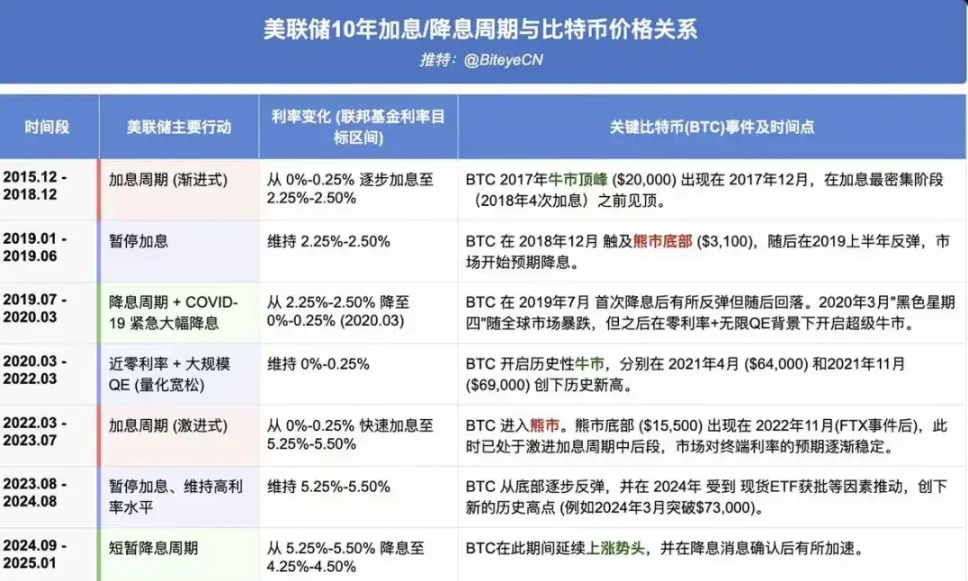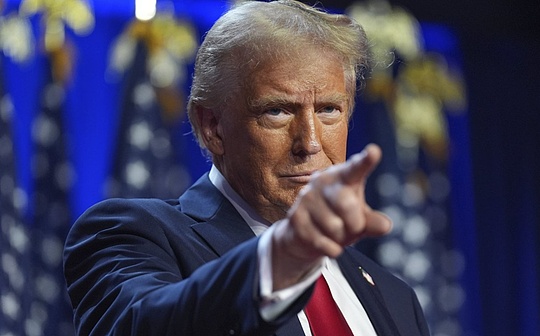Review of the Fed's 10-year interest rate cycle: Where will Bitcoin go under the deduction of the best, medium and worst paths?

Reprinted from panewslab
04/09/2025·1MIn the past decade, Bitcoin’s bull top and bear bottom have been a mapping of the Federal Reserve’s interest rate policy.
- At the top, often happens when the rate hike is expected to be the strongest
- At the bottom, it is accompanied by the expected turn to a rate cut
Now, the market is at the fork in three ways:
- Restart interest rate hike → Second bottoming out?
- Rate cuts in the second half of the year → Will it hit the top after fluctuation?
- Rate cuts in the middle of the year → Bull market accelerates?
These paths determine how to go next for Bitcoin.
This article will disassemble the BTC trend in three situations and understand the game logic of macro + price at one time.

1. After the Fed's 10-year interest rate policy review, how does
Bitcoin's "top" echo the "bottom" and "bottom"?
In the past decade (about 2015-2025), the Federal Reserve has experienced a complete cycle of interest rate hikes, interest rate cuts, interest rate hikes and further pauses. After sorting out this history, we found that the turning point of Bitcoin price has a playful relationship with the Fed's policy nodes, especially the "early response" phenomenon expected by the market.
Let’s talk about the conclusion first:
1. The bull market is often ahead of the start or acceleration of interest rate hikes, and the market trades in advance to tighten expectations.
2. The Bitcoin bear bottom usually occurs after the interest rate hike, during the suspension of interest rate hikes, or before the start of the interest rate cut cycle. The market looks for the bottom when the most pessimistic or loose expectations emerge.
3. "Big Lift" such as quantitative easing (QE) or rapid rate cuts are important catalysts for the bull market.
The following is a comparison table of the Federal Reserve's main interest rate policies and key Bitcoin trends in the past decade:

This table clearly shows the "time difference" between the key turning point in Bitcoin price and the Fed's policy cycle. Whether it is the peak of the bull market in 2017 or 2021, it happens before the "hammer" of interest rate hikes really falls or the strongest rate hikes. The bottom of the bear market is often accompanied by expectations of a shift to a rate cut.
It is currently in a platform period of "suspended interest rate hikes" + "short-term interest rate cuts". The market is waiting for the next clear direction signal - whether it can cut interest rates again and enter the "big-flow" stage of quantitative easing.
2. Interest rate deduction: Three ideas based on institutional forecasts
Currently (April 2025), there are obvious differences in market differences regarding the Fed's next move. We have summarized three possible scenarios based on the recent views of many mainstream research institutions:
1. Worst Case (worst case): Facing the risk of interest rate hikes from 2025 to 2026
- JP Morgan (JP Morgan, early March report view): Although it is predicted to cut interest rates, it also clearly pointed out that if employment and inflation data are unexpectedly strong, the possibility of a rate hike will not be ruled out.
- LSEG (Long Kong Stock Exchange Group, early April report view): Emphasizing the rise in "stagflation risks" and inflation stickiness, and believes that the reasons for supporting the "extending policy suspension period" are very sufficient.
The potential upward risks of tariff policies and geopolitics to inflation may force the Federal Reserve to maintain tightening, which may lead to a high interest rate environment throughout the year and market liquidity continues to be under pressure.
2. Base Case (benchmark): Start a rate cut in the second half of the year, 2 times a year
- JP Morgan (JP Morgan, early March report view): predicts that the Fed will remain patient until June, then cut interest rates twice, and by the end of Q3, the interest rate dropped to 3.75% -4.00%.
- EY (EY, March report view): It is expected to cut interest rates by 25 basis points in 2025, respectively in June and December.
- Federal Reserve meeting in March: Most officials still expect two rate cuts in 2025, with annual interest rates down to 3.75% to 4%.
These views believe that despite the sticky inflation, the overall trend is downward and the economy and job markets will gradually cool down. The market fluctuated while waiting in the first half of the year, and the interest rate cut cycle began in the second half of the year.
3. Best Case (best case): Start a rate cut in the middle of the year, 3 or more times throughout the year
- Morningstar (views of the report on March 28): It is expected that the first rate cut may be in June, with a total of three interest rates cuts (75 basis points) in 2025, and the interest rate at the end of the year dropped to 3.50% -3.75%.
- Plymarket: According to Polymarket data, the most bet situation is a three-time rate cut (75 basis points) throughout the year, accounting for about 20%. The second is the rate cuts of 4 times (100 basis points) and 5 times (125 basis points), accounting for 18% and 13.3% respectively, reflecting that some markets are heating up on aggressive easing paths. The most optimistic scenario at the beginning of the year, "only two interest rate cuts" has now fallen back to around 13%. Overall, the market has basically reached a consensus on "the interest rate cut will be at least 2 times in 2025", but there are still many differences on whether it will enter a stronger release cycle and expectations have not yet been anchored.
These views suggest that if inflation drops faster than expected or the economy is significantly weaker, the Fed may implement three or more rate cuts in 2025.
3. Bitcoin price deduction: Under the three interest rates, what will
the price trend of Bitcoin be?
Based on the above three well-documented interest rate scenarios, we deduce the next price trend of Bitcoin:
1. Worst Case (risk of interest rate hikes in 2025-2026): The top has appeared or the bottom is second, and bear market thinking leads
Trend Deduction: If the market confirms that there is a risk of interest rate hikes, Bitcoin will likely be subject to selling pressure in Q2 and after 2025. The previous high may be the final peak of this cycle. Market sentiment will turn to pessimism, and there may be a deep pullback. Test the key support below, and even the possibility of a second bottoming out cannot be ruled out.
Cycle vertex judgment: It can basically be confirmed that the vertex has passed, and it is likely to be in a downward relay or bottom fluctuation in 2025.
2. Base Case (refund cuts started in the second half of the year, 2 times a year): Patiently fluctuate, impacting the peak area at the end of the year
Trend Deduction: During the Q2-Q3 period, waiting for a clear signal for interest rate cuts, Bitcoin is likely to maintain a high-level wide fluctuation. Market sentiment will fluctuate with the data. Once the rate cut is confirmed at the end of Q3/Q4 and the first rate cut is implemented, it may trigger the last sprint of the bull market, but this is more likely to be the "last train" market driven by sentiment and liquidity expectations.
Periodic vertex judgment: This may be consistent with some predictions of the halving cycle model in Q4 2025 or early 2026. It should be noted that when the news of interest rate cuts is fulfilled, the market may have fully priced, and even a "selling fact" pullback occurs. The real price peak may be when the expectation of interest rate cuts is strongest but not fully implemented.
3. Best Case (start interest rate cuts in the middle of the year, 3 times or more throughout the year): The bull market accelerates, the top is ahead of schedule and may be higher
Trend Deduction: If the unexpected economic weakening forces the Federal Reserve to cut interest rates early, it will greatly boost market risk appetite. Bitcoin is expected to quickly get rid of the volatility and launch a strong offensive, leading the entire crypto market to enter a fanatical stage.
Periodic vertex judgment: It may be advanced to the early stages of Q3 or Q4 in 2025. Easing liquidity that comes earlier may boost prices to higher levels, but the duration of the entire cycle will be reduced accordingly.
4. Summary
The Federal Reserve's interest rate decisions are still the anchor of global asset pricing, especially for assets like Bitcoin with high volatility. Although the market has repeatedly joked about the ups and downs, according to the forecasts of major mainstream institutions, it is still at a critical juncture in which expectations are swinging. While lowering your position, you may be able to retain a glimmer of hope.



 jinse
jinse
 chaincatcher
chaincatcher